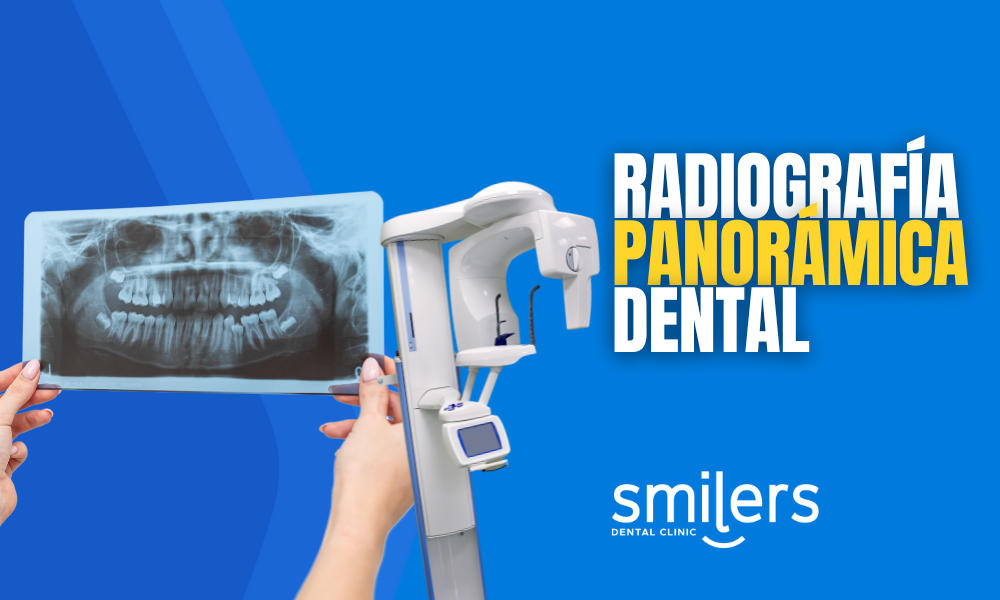Panoramic dental radiography is a radiological test whose main objective is to recreate the bony structures of the patient’s face. In this way, the specialist will be able to obtain a sample of the maxillary bone, the jaw and the dental pieces.

It is considered one of the most necessary tests in the dental sector, so in this article we will explain everything you need to know about this test.
On the other hand, you should know that it is used for a wide variety of dental treatments.
Many dentists consider it as the first step before starting any dental treatment, since the panoramic serves to know the current state of your teeth.
How much does a panoramic dental x-ray cost?
The price may vary depending on the laboratory where the test is performed; however, in Mexico it usually costs between 300 and 500 pesos or between 17 and 30 dollars, mainly in border cities, the price for the lateral skull is usually the same.
Please note that the place where you take the test must have a certificate from the COFEPRIS. Also that the device with which it is performed is an X-ray machine, its price is due to the fact that these machines usually cost between 40,000 and 50,000 dollars.
Duration
Also known as orthopantomography, it is carried out through a simple, quick and painless process, since in just a few minutes the samples required to analyze the patient’s situation will have been taken.
Following the established protocols, the procedure should not take more than 10 minutes, that is, from the moment you enter the laboratory and your dentist receives the result, assuming that the dental clinic where you are treated has this type of technology.
What is a panoramic dental X-ray used for?
As we have already mentioned in the previous point, the main function of a panoramic X-ray is to determine the problems or pathologies that the specialist cannot detect through a visual examination.
- Insertion of dental implants: Panoramic X-ray is crucial to evaluate the quantity and quality of the bone where the implants will be placed.
- Orthodontic procedures: This type of X-ray helps to visualize tooth alignment and bone structure, which is vital for orthodontic treatment planning.
- Smile design: Through this x-ray, dentists can get a complete picture of your teeth and surrounding structures, which is helpful in designing a perfect smile.
- Dental Bridges: Before a dental bridge is placed, x-rays can help assess the health of the adjacent teeth and underlying bone to ensure adequate support.
- Endodontics: In root canal treatment it is used to evaluate the shape and depth of the dental roots.
- Dental extractions, including wisdom teeth: X-rays help identify the position of the root and surrounding structures, such as nerves and sinuses, for safer extraction.
- Diagnosis of periodontal disease: This type of X-ray allows the evaluation of bone loss around the teeth, which is crucial for the treatment of gum disease.
- Evaluation of cysts or tumors: Panoramic radiography can detect abnormalities in the maxillary and mandibular bone, facilitating early diagnosis of cysts or tumors.
- Complex dental restorations: For treatments such as crowns or complete dentures, it provides a global vision that facilitates treatment planning.
- Trauma assessment: After an accident involving the facial area it may be useful to assess the extent of damage.
These are just a few of the many dental treatments that could benefit from panoramic radiography, making it an indispensable tool in modern dentistry.
Steps to take a panoramic radiograph
Panoramic dental x-ray is a simple and quick procedure that uses an x-ray machine to obtain a complete view of your mouth. The device rotates around your head, capturing two-dimensional images that are then digitized.
Time required: 10 minutes.
Here are the common steps that are followed during a panoramic dental x-ray.
- Registration and Documentation. At your first visit, you will be asked to complete a series of medical forms and consent to the procedure.
- Patient Preparation: Before the test, you will be asked to remove any metal objects from your head and neck, such as earrings or necklaces.
- Positioning in the Machine: You will be guided to the X-ray machine and placed in the appropriate position.
- Placement of the Protector: A lead shield will be placed around your neck to minimize radiation exposure.
- Start of scanning: Once you are in position, the device will begin to rotate around your head to perform the scan. This process usually takes less than a minute.
- Technician’s Review: The technician will ensure that the images are clear. If necessary, the process may have to be repeated.
- Digitization and Shipping After capture, the images are automatically digitized and sent to the computer for examination by the dentist.
- Analysis of Results: Your dentist will receive and analyze the images, which will usually be ready in about 10 minutes, considering possible delays.
- Post-Procedural Consultation:The dentist will discuss the results with you and plan any additional treatment if necessary.
This is a mandatory test for treatments such as dental implants and, thanks to the panoramic X-ray, the specialist will be able to determine the ideal place where the implant will be placed.
Advantages
In the following, we will learn the main pros and cons of this test and, in this way, we will understand the reasons why so many patients undergo this radiological test.
- Speed and Comfort: The process is simple and takes only 10 seconds, without causing discomfort to the patient.
- Complete Information: Provides a comprehensive view of all oral tissues, including the mandible and maxillary bones.
- Treatment Versatility: Commonly used to plan various dental treatments and evaluate the patient’s overall oral health.
- Usefulness in Emergency Cases: It can be used in emergency situations such as accidents or trauma for a quick diagnosis.
- The best diagnostic method: It is always advisable to start any treatment with an X-ray, so that the dentist will be able to detect any other ailment, even if you go for a dental cleaning.
It is evident that the multiple advantages offered by this process explain the reason why panoramic dental X-rays are so widely used nowadays and everything indicates that this trend will continue to grow in the near future.
This post is purely informational and does not replace a consultation with the dentist in any way. Contact the smile agents team to schedule an appointment with one of the dentists at Smilers Dental Clinic.


